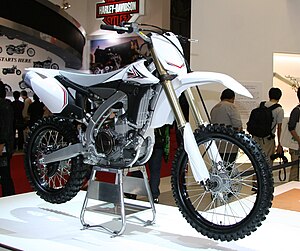YZ400F
 |
|
| Manufacturer | Yamaha Motor Company |
|---|---|
| Class | |
| Engine | DOHC, multivalve, water-cooled, four-stroke, single |
| Production | 1998-2000 |
|---|---|
| Predecessor | YZ250 2-stroke |
| Successor | YZ426F |
| Engine | Five-valve, 400 cc, compression ratio 12.5:1 |
| Transmission | 5-speed |
| Weight | 250 lb (110 kg) (dry) |
| Production | 2000-2003 |
|---|---|
| Predecessor | YZ400F |
| Successor | YZ450F |
| Engine | Titanium five-valve, 426 cc, 95mm x 60.1mm stroke, compression ratio 12.5:1 |
| Transmission | 5-speed |
| Suspension | Kayaba |
| Brakes | Disks |
| Wheelbase | 58.7 in |
| Fuel capacity | 2.1 gallons (7.95 L) |
| Production | 2003-2005 |
|---|---|
| Predecessor | YZ426F |
| Engine | Titanium five-valve, 449 cc, 95.0 x 63.4mm, compression ratio 12.3:1 |
| Transmission | 2003-2004: 4-speed 2005: 5-speed |
| Frame type | Steel |
| Related | YZ250F, WR450F |
| Production | 2006-2009 |
|---|---|
| Predecessor | YZ456F |
| Engine | Titanium five-valve, 449 cc, 95.0 x 63.4mm, compression ratio 12.3:1 |
| Transmission | 5-speed |
| Frame type | Aluminum |
| Related | YZ250F, WR450F |
| Production | 2010-Present |
|---|---|
| Engine | Rear slant, titanium four-valve, 449 cc, 97.0mm x 60.8mm stroke, compression ratio 12.5:1 |
| Transmission | 5-speed |
| Related | WR450F, YZ450FX |
The Yamaha YZ450F is a four-stroke racing motocross bike built by Yamaha Motor Corporation. It was the successor to the previous YZ426F which was discontinued in 2003. It is credited by Cycle World and Dirt Rider magazines as the bike that started the four-stroke dirt bike revolution. It is a replacement for the YZ250, which is slowly being phased out. The 2006 YZ250F and YZ450F were the first production motorcycles equipped with titanium suspension springs.
The WR450F is the enduro version of the YZ450F.
For many years, the motocross world almost exclusively used two-stroke engines. AMA racing classes had two classes: 125 cc and 250 cc two-strokes, with no provision for four strokes. Most riders considered four-stroke engine technology to be largely utilitarian and uncompetitive, relegated solely for trail riding.
In 1996, the AMA changed racing rules to allow 450 cc four strokes to compete in the same racing class as 250 cc two-strokes. Yamaha engineer Yoshiharu Nakayama first came up with the idea of creating the first competitive four-stroke race motocross bike. The Yamaha YZ400F was developed to fit into this category. It solved the power dilemma by borrowing superbike technology and giving the YZ a five-valve head, liquid cooling and a 12.5-1 compression ratio.
In 1997, Yamaha rocked the motocross world with the introduction of the YZ400M prototype, a concept motorcycle which borrowed much technology from road racing. The YZM was far ahead of all competition among four-stroke motocross bikes. piloted the YZ400M to its first victory in 1997 at the Las Vegas Supercross. This was the first time any four-stroke had won an AMA event. The YZ400M was the predecessor of the production YZ400F, which was released the next year.
Yamaha introduced the YZ400F in production in 1998 after a successful AMA season in 1997. It was "the first modern production four-stroke motocrosser that was directly competitive against two-strokes." Initially, Yamaha targeted a dry weight of 233 pounds (106 kg) (on par with the 250 two-strokes of the time), but by production, the bike weighed 250 pounds. The bike had an 11,600 rpm redline power and torque close to its 250 cc two-stroke rivals. It benefited from engine compression braking, which allowed the engine to slow the bike down during deceleration, giving the brakes a rest. The 1998 YZ400F was the first bike to come stock with a Keihin FCR carburetor.
...
Wikipedia
